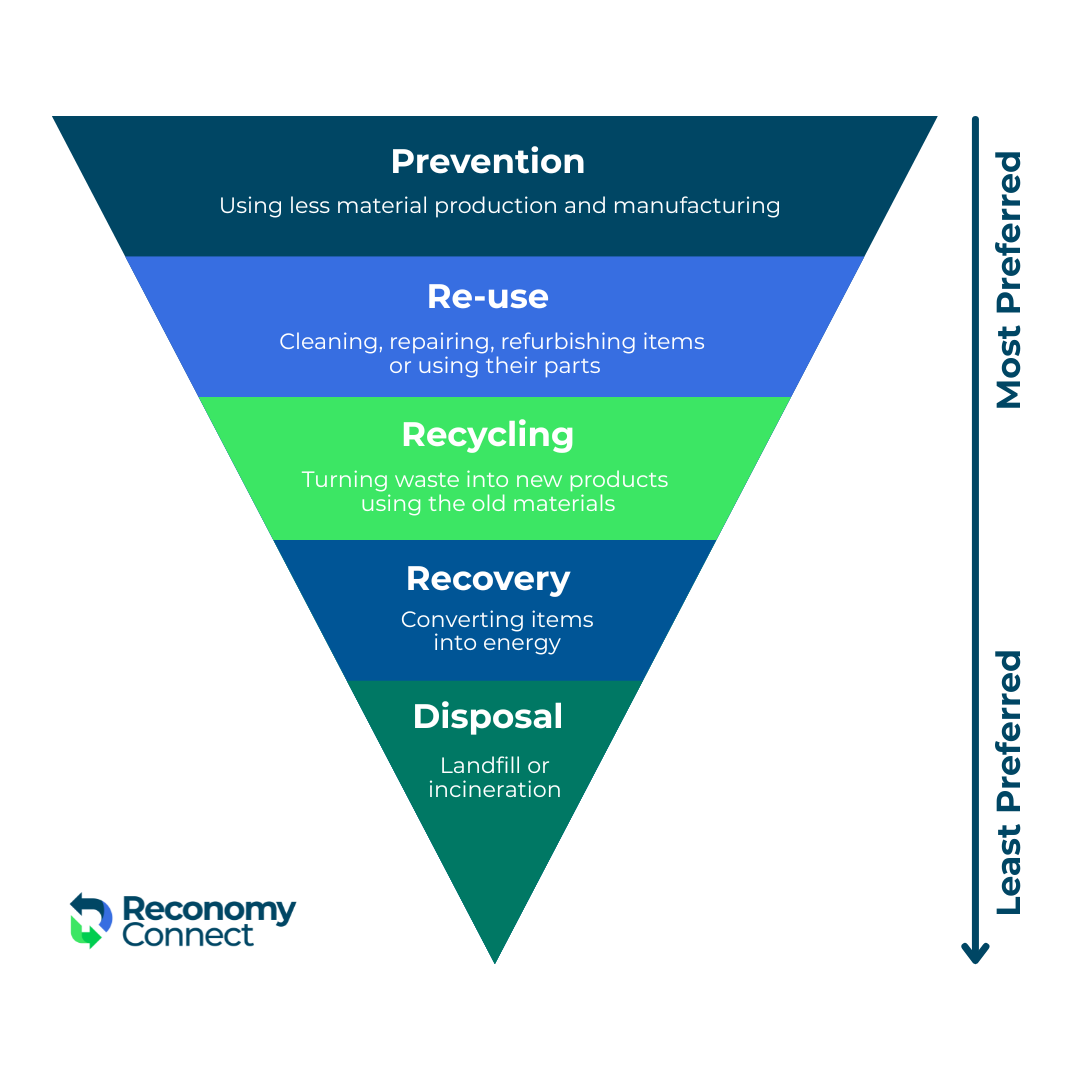The Waste Hierarchy vs. The Traditional Four Methods: A Comprehensive Comparison of Waste Management Strategies
The Waste Hierarchy
The Waste Hierarchy is a widely recognised government guidance that ranks waste management options according to what is best for the environment. It contains five sections that range from least favoured to most favoured approaches.
It gives top priority to preventing waste in the first instance. When waste has to be created, it encourages preparing it for re-use, then recycling, then recovery. The finally section is disposal, such as incineration or landfill.

Key Takeaways of the Waste Hierarchy:
- The waste hierarchy is designed to help businesses prioritise the least harmful methods first, such as prevention and reuse. It is easy to follow and lays out a journey to take.
- The main aim should always be for waste creation to be prevented altogether, which is why it’s placed at the top of the hierarchy. However, this does depend on the type of business, and could include initiatives like better product design, to having plastic-free packaging in the office canteen.
- Recovery and disposal come at the bottom because they tend to have more direct environmental consequences, such as pollution or resource depletion.
Traditional 4 Types of Waste Management
The traditional four types of waste management cover similar aspects for managing waste effectively, including:
- Source Reduction: reducing the generation of waste through innovative product design, packaging optimisation and consumption reduction.
- Recycling and Reuse: the collection, sorting, processing and remanufacturing of materials to produce new products or raw materials to be used again.
- Waste-to-Energy Conversion: conversion of non-recyclable waste materials into energy generating heat, electricity or biofuels.
- Landfill Management and Remediation: safe and environmentally responsible disposal of waste that cannot be prevented, recycled, reused or recovered.
How do they compare?
Whilst both the waste hierarchy and the four types share common goals, they differ in approach, emphasis and prioritisation.
- Approach to Waste: The waste hierarchy emphasises a clear stratified approach that businesses can follow in order to establish sustainable waste management processes. The four types of waste management are more varied and don’t follow on from each other, incorporating strategies that range in environmental focus.
- Focus: The waste hierarchy is primarily concerned with reducing environmental harm. On the other hand, the four types of waste management offer more strategies that can be applied based on various factors. For businesses looking to improve their environmental practices, the waste hierarchy would be best to follow.
- Concept versus Action: Strategies within the traditional four types are more established and offer real world practices that can be easily reproduced. The waste hierarchy, by contrast, is more of a conceptual framework to guide decision-making about waste management, from design to disposal. As a government policy, it acts more as encouragement than action.
Which is the best to use?
In summary, while both frameworks share the goal of reducing waste and minimising environmental impacts, the waste hierarchy is a conceptual guide that can assist businesses in what to prioritize if they want to thrive sustainably.
The four types of waste management represent more practical, often sector-specific strategies used to manage waste at various stages of the waste lifecycle.
For those businesses looking to improve their sustainability efforts, adopting the waste hierarchy can help to reduce the environmental footprint and create a cleaner, cost-effective operation.
How can you apply it to your business?
We would recommend using the waste hierarchy as a tool to firstly benchmark against and to then track progress against. Reconomy Connect can work with your business in a number of areas to target action that is fundamentally linked to the waste hierarchy. We use a technology-led approach that facilitates transparency and automation. This can help you encourage a circular design and ultimately improve sustainability efforts.
Get in contact today to see how we can help your business!

